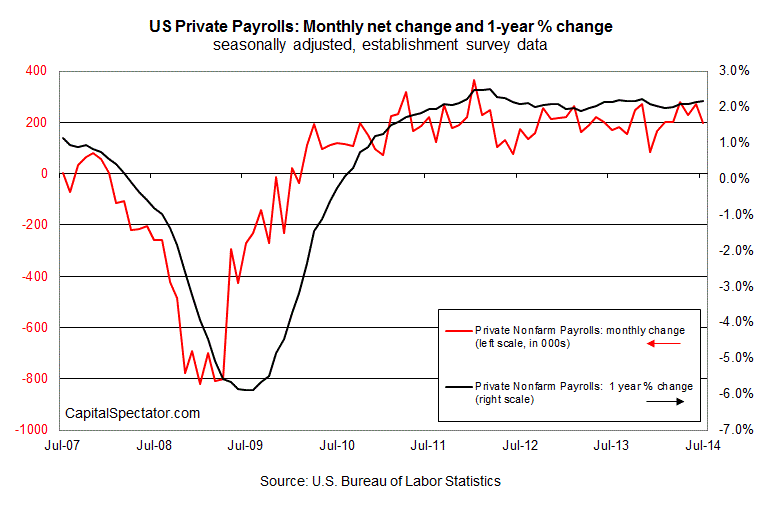The US economy minted fewer jobs than expected in July, although the year-over-year change in private-sector payrolls inched higher, reaching an eight-month peak, the Labor Department reports. Meanwhile, personal income and spending in June rose in line with expectations, according to this morning’s update from the US Bureau of Economic Analysis. Although the talking heads are playing up the monthly comparisons and drawing any number of dramatic conclusions, the real story is that nothing much has changed via today’s data points in terms of the trend for the art/science of monitoring business cycle risk.
Let’s start with private payrolls. Although the monthly gain of 198,000 was disappointing relative to expectations and the recent run of 200,000-plus monthly gains, the trend still looks encouraging. Private-sector nonfarm payrolls rose 2.16% for the year through July—the strongest pace since last November’s 2.21% increase. Does this mark a dramatic change for the better? No, at least not based on the data in hand. But the annual changes continue to suggest that the labor market is still growing at a moderate pace, just as it’s been doing in recent history, albeit with some temporary bumps along the way.
Moving on to income and spending, the modest growth trend of recent vintage is more or less holding steady here as well. Disposable personal income increased 0.4% in June vs. the previous month, which translates into a 3.9% increase vs. the year-earlier number. That’s a touch below the previous 4.0% annual increase, but hardly a sign of trouble at this point in terms of a major deviation from the trend. Personal consumption expenditures delivered a similar story in the June release. The 0.4% monthly gain was a bit higher than the 0.3% advance in the previous report. More importantly, the annual pace is holding steady with a 4.0% rise through June, virtually unchanged from May’s year-over-year increase.
Meanwhile, there’s been a lot of chatter lately about the Fed’s focus on wages as a key factor for deciding on the timing of raising interest rates. But here too we have a case of more of the same. Private-sector wages increased 0.5% in June, unchanged from the previous monthly comparison. In annual terms, private wages rose 5.8% through June, a hair below the 5.9% gain through May.
The bottom line: today’s reports on payrolls and income and spending suggest that the trend remains the same: modest growth with a bias for more of the same in the near term. It’s fair to say that today’s macro releases are a bit of a yawn, at least if you’re looking for drama, for good or ill. But in the cause of monitoring the business cycle for signs of change, there’s not much in the way of red meat in the data du jour. Next week, perhaps. Meantime, the latest figures suggest that the US economy is humming along at a modest rate of growth in mid-summer 2014. Yes, there’s still no shortage of things to worry about–the housing market, for one. But the big-picture interpretation for today’s numbers imply that growth in a moderate degree is still the path of least resistance.

